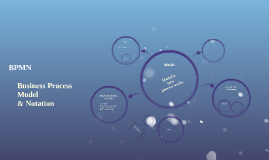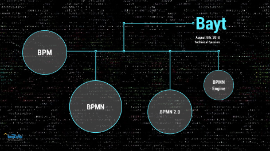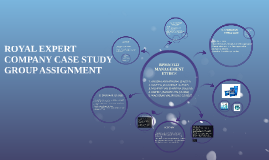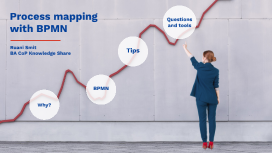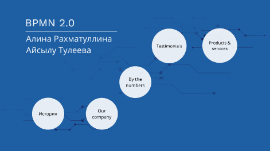BPMN
Transcript: Bayt August 9th, 2018 Technical Session BPM BPM Business Process Management (BPM) Business process management (BPM) is the discipline of improving a business process from end to end by analyzing it, modelling how it works in different scenarios, executing improvements, monitoring the improved process and continually optimizing it. Professionals in sales, project management, and other areas use business process management (BPM) and business process modeling software to map out their approach to any specific process. What is BPMN? BPMN Business Process Modeling Notation (BPMN) is a flow chart method that models the steps of a planned business process from end to end. A key to Business Process Management, it visually depicts a detailed sequence of business activities and information flows needed to complete a process. Process Example Process Why BPMN? Why should I care about BPMN? Business Process Model and Notation (BPMN) is the global standard for process modeling and one of the most important components of successful Business-IT-Alignment. More and more organizations are using BPMN and in more and more universities BPMN is taught as a subject. These are the reasons: Standard Simplicity Power of expression Implementation in IT BPMN is not owned by a certain enterprise but by an institution (OMG), which is already established through other world-wide standards, e.g., UML. The standard is supported by many software products; you are less dependent on any particular vendor's products. Standard The principle behind BPMN is rather simple which is why you can start working with this notation very quickly. Simplicity If necessary, you can describe precisely how a process functions with BPMN. However, this is more difficult than only roughly describing the process. This way of precise modeling is possible, but not mandatory. Power of expression BPMN has been primarily developed to support technical implementation of processes ("Process Automation"). The more important the IT is in a company, the more helpful the use of BPMN becomes. Implementation in IT Business Process Management Initiative (BPMI) developed BPMN, which has been maintained by the Object Management Group since the two organizations merged in 2005. Version 2.0 of BPMN was released in January 2011, at which point the name was adapted to Business Process Model and Notation as execution semantics were also introduced alongside the notational and diagramming elements. BPMI BPMI BPMN 2.0 BPMN 2.0 The vision of BPMN 2.0 is to have one single specification for a new Business Process Model and Notation that defines the notation, metamodel and interchange format but with a modified name that still preserves the "BPMN" brand. Aligning BPMN with the business process definition meta model BPDM to form a single consistent language. Enabling the exchange of business process models and their diagram layouts among process modeling tools to preserve semantic integrity. Expand BPMN to allow model orchestrations and choreographies as stand-alone or integrated models. Support the display and interchange of different perspectives on a model that allow a user to focus on specific concerns. Serialize BPMN and provide XML schemes for model transformation and to extend BPMN towards business modeling and executive decision support. The final version of the specification was released in January, 2011. Features Features Flow objects: events, activities, gateways Connecting objects: sequence flow, message flow, association Swimlanes: pool or lane Artifacts: data object, group, annotation Basics Basics Flow objects Flow Objects Connection Objects Connection Objects Swimlane SwimLanes Artifacts Artifacts BPMN Engine BPMN Engine The Workflow Engine executes most of the symbols defined in the BPMN 2.0 standard. With BPMN, you can express reliable service orchestration, human task flows, event handling and much more in diagrams that are technically executable yet easy to understand for everyone. What is a BPMN Engine(Workflow Engine)? What is BPMNE? Thanks to the pre-built integration with the DMN (Decision Management Engine), you can easily execute decision tables from within a BPMN process. Decision Management Engine DMN






